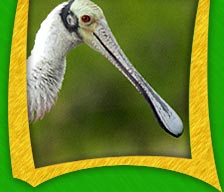|
TOUCH, BUT DON'T LOOK
Wood Storks capture their prey
using touch, not sight. Marshlands,
swamps and other shallow grounds are heavily vegetated and contain
murky waters, which make it difficult to see fish and other insects.
To get around this, Wood Storks sift their open beaks in mud to unearth
potential prey. The instant an animal touches the bill it immediately
snaps shut. This technique of groping for food is known as “tacto-location.”
FASHION BACKWARD
In the late19th century, fashion was deadly…at
least for a Roseate Spoonbill it was; its pink feathers were in
such high demand for use in ladies hats and fans that Roseate Spoonbills
nearly became extinct. Thanks to a variety of protective efforts,
Roseate Spoonbills are no longer on the endangered species list.
HE'S NOT HERON, HE'S MY BROTHER
For years, scientists believed the Great White
Heron was a species separate from the Great Blue Heron. We now
know that these “Great
Whites” are simply a white version of their blue-feathered
brothers and sisters. Great White Herons nest almost exclusively
in South Florida. This may have been the initial
reason why researchers classified the two birds separately.
Resources for this article
have been provided by the
Naitonal Park
Service and
the Florida Fish
and Wildlife Conservation Commission .
|










